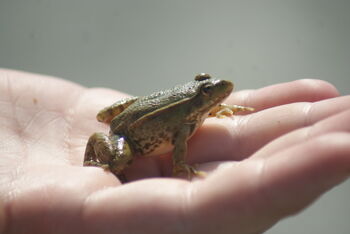
Marsh Frog - WWC Archives
The Marsh Frog (Rana ridibundus) is a very large species of frog which inhabits South East England.
Characteristics[]
The Marsh Frog is a water-dwelling, generally green-colored frog species. It can reach a maximum length of 17 centimetres, but males remain smaller (around 12 cm). The head is proportionally large and the hind legs are long, which gives them excellent jumping abilities.
There is a large variation in colour and pattern, ranging from dark green to brown or grey, sometimes with some lighter green lines; a lighter line on the

Marsh Frog Wikipedia
back is generally present. The Western European populations are generally dark green to black with dark spot on the back and sides and three clear green lines on the back.
The Marsh Frog usually breeds in more brackish (salt and freshwater mixed) ditches, ponds etc or larger ponds and lakes near the coastline.
Oare Marshes and Elmley Marshes are strongholds for these frogs in North Kent. Interestingly, despite having freshwater ponds at the site, there have been few/none recorded Common Frogs or Toads at the site. Many are concerned that they are affecting our native amphibian populations by creating competition for food although it is not proven.
Diet[]
The diet of the Marsh Frog consists of dragonflies and other insects, spiders, earthworms and slugs. Larger frogs also eat small rodents and sometimes smaller amphibians and fish.
